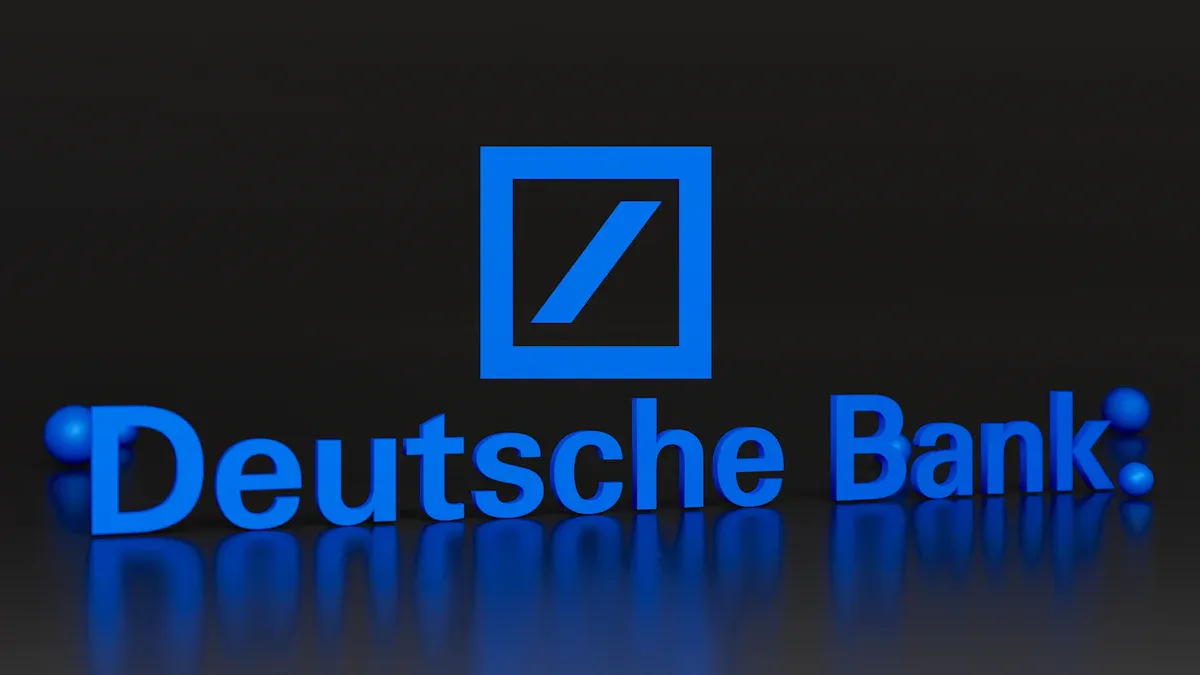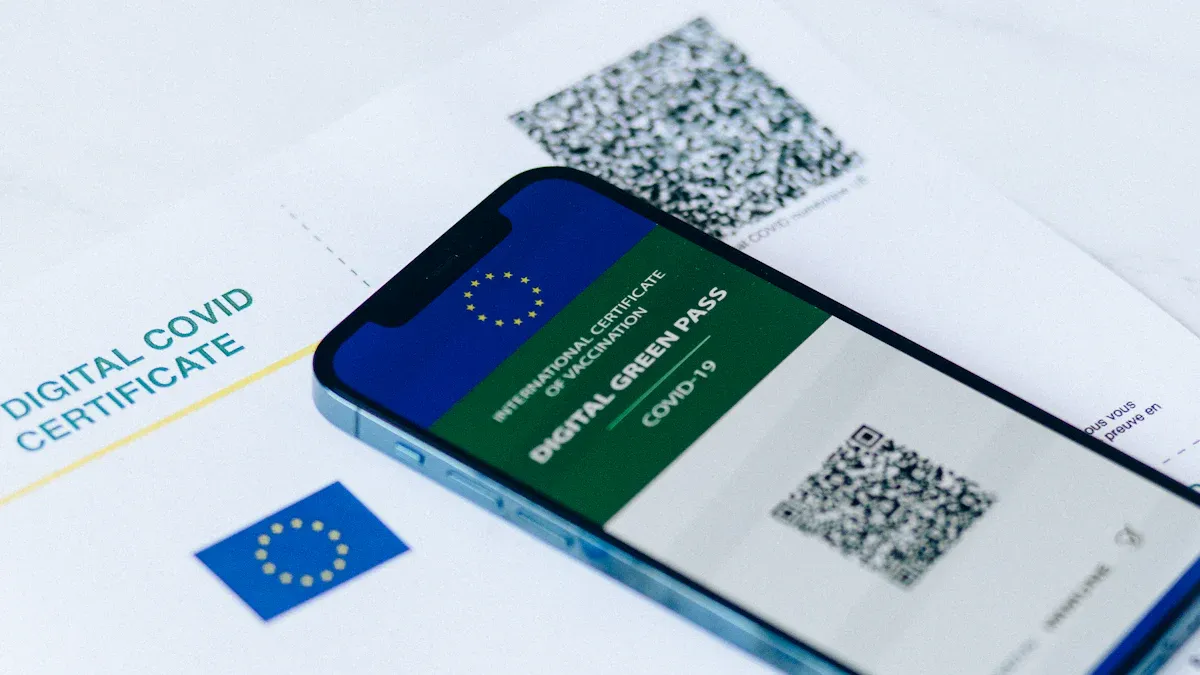- EasyCard
- Trade
- Help
- Announcement
- Academy
- SWIFT Code
- Iban Number
- Referral
- Customer Service
- Blog
- Creator
How to Tell IBAN and SWIFT Code Apart for Worldwide Transfers

Image Source: unsplash
You might feel confused when you see both IBAN and SWIFT codes required for an international money transfer. These codes often look similar, but they serve different purposes. Using the correct code helps your funds reach the right place quickly. A simple mistake can cause delays or even failed transfers. Many people want to know how to spot the IBAN and use it correctly, especially when sending money to or from Hong Kong banks.
Key Takeaways
- IBAN identifies a specific bank account, while SWIFT code identifies the bank itself for international transfers.
- Use IBAN mainly for European countries and SWIFT codes globally, especially for places like Hong Kong and China.
- Always double-check both IBAN and SWIFT codes before sending money to avoid delays or failed transfers.
- You can find your IBAN and SWIFT codes on bank statements, online banking, or by contacting your bank directly.
- Using the correct codes ensures your money reaches the right place quickly and keeps your transfer safe.
IBAN vs. SWIFT Code
Main Difference
You often see both IBAN and SWIFT code fields when you make an international money transfer. These two codes serve different roles. The SWIFT code acts as a bank identifier. It tells the system which bank or branch should receive your payment. The IBAN, on the other hand, points to the exact bank account that will get the funds. You can think of the SWIFT code as the address of the bank, while the IBAN is the address of the specific account inside that bank.
To help you see the key differences, look at the table below:
| Aspect | IBAN (International Bank Account Number) | SWIFT Code (BIC) |
|---|---|---|
| Purpose | Identifies an individual bank account involved in an international transfer | Identifies a specific bank or financial institution globally |
| Structure | Up to 32 alphanumeric characters: starts with 2-letter country code, 2-digit checksum, followed by bank and account details | 8 to 11 alphanumeric characters: 4-letter bank code, 2-letter country code, 2-character location code, optional 3-character branch code |
| Usage Region | Primarily used in European Union and neighboring countries; recognized but not used in US and Canada | Used globally, including outside Europe; default standard for international transfers outside Europe |
| Standards Body | Developed and standardized by ISO (International Organization for Standardization) with input from European Payments Council | Managed by SWIFT organization, a global cooperative for financial messaging |
| Identifies | Specific bank account number, bank, and country | Bank or financial institution only; does not identify individual account number |
| Additional Notes | Includes validation features like fixed length and uppercase letters | Enables secure messaging and transmission of financial instructions among institutions |
When you compare IBAN vs. SWIFT code, you see that the SWIFT code helps the payment system find the right bank, while the IBAN ensures the money lands in the correct account. This distinction matters for every international transaction.
Purpose in International Money Transfers
You need to use both codes correctly to make sure your international payments go through without problems. The SWIFT code routes your payment to the right bank, even if that bank is in Hong Kong, China, or another country. The IBAN then directs the funds to the exact account within that bank. This process helps prevent errors and speeds up international transfers.
Recent changes in international banking have made these codes even more important. Here are some updates you should know:
- Over 70 countries, including Switzerland, China, India, and Japan, now use the ISO 20022 standard for financial messaging.
- In March 2023, SWIFT updated its payment formats to match ISO 20022. This change allows banks to use richer data, process payments faster, and improve accuracy.
- U.S. Bank and other major banks have improved their digital tools to help you provide the right wire information, including country-specific requirements.
- These updates aim to make international money transfers more transparent, efficient, and compliant with global rules.
If you use the wrong IBAN or SWIFT code, your payment may not reach the intended recipient. Here is what can happen:
- If you enter the wrong SWIFT code, your bank will try to send the money to the wrong bank. If the code does not exist, your bank will refund your money.
- If the SWIFT code exists but does not match the IBAN’s bank, the receiving bank will reject the payment and notify your bank, which will then return your funds.
- The refund process can take several days.
- Using the wrong IBAN is more serious because the IBAN points to a specific account. However, IBANs have built-in checks to catch most typing mistakes.
- In most cases, payments with incorrect codes do not reach the recipient, but your money remains safe and will be returned after processing.
Knowing the difference between IBAN vs. SWIFT helps you avoid these problems. You can make international money transfers with confidence when you use the correct codes. Always double-check both codes before you send an international payment. This step saves you time and prevents delays in your international transaction.
What Is an IBAN?
IBAN Format
You may see the term IBAN when you send money internationally. IBAN stands for International Bank Account Number. Banks use this system to make sure your money reaches the right account, even if you send it across borders. The IBAN code gives a unique identity to each bank account, which helps prevent errors in transfers.
The IBAN format follows a clear structure. Each IBAN number starts with a two-letter country code. After that, you see two check digits. These digits help banks check if the IBAN is valid. The rest of the IBAN contains the Basic Bank Account Number (BBAN). The BBAN part can be up to 30 characters long and includes details like the bank and branch. The total length of an IBAN ranges from 16 to 34 characters, depending on the country. This structure allows each country to include its own banking details while keeping the IBAN easy to use for international transfers.
Tip: Always double-check the IBAN number before sending money. Even one wrong digit can delay your transfer.
Here is an example of how an IBAN might look for a Hong Kong bank:
HK12 3456 7890 1234 5678 90
This example shows the country code (HK), check digits (12), and the rest as the BBAN.
Where IBAN Is Used
You will find IBAN codes in many countries, especially in Europe. The Single Euro Payments Area (SEPA) includes all European Union countries and some non-EU countries. These countries use the IBAN system for euro transfers. This makes cross-border payments within SEPA fast and simple. Outside SEPA, some countries have also adopted the IBAN code for international transfers, but not all countries use it yet.
If you want to send money to a bank in Hong Kong, you may not always need an IBAN. Many Hong Kong banks do not use the IBAN system, but they can process transfers using other details like the SWIFT code. Always check with your bank to see if you need an IBAN code for your transfer.
Note: The IBAN system helps banks identify accounts worldwide, but not every country uses it. Always confirm the requirements for your destination country before making a transfer.
What Is a SWIFT Code?

Image Source: unsplash
A SWIFT code helps you send money to banks around the world. This code acts as a bank identifier. When you make an international transfer, the SWIFT code tells the system which bank should receive your money. You can think of it as a special address for each bank. The SWIFT network connects thousands of banks and financial institutions. This network makes sure your money moves safely and quickly between countries.
SWIFT Code Format
A SWIFT code has either 8 or 11 characters. Each part of the code gives important information. The first four letters show the bank. The next two letters tell you the country. The following two characters show the city or location. If the code has three more characters, these identify the branch. For example, a Hong Kong bank might have a SWIFT code like this:
HASEHKHHXXX
In this example, “HASE” stands for the bank, “HK” is for Hong Kong, “HH” shows the location, and “XXX” is the branch. Every bank has a unique swift code. This helps the swift network find the right place for your money. You may also hear people call these swift/bic codes. Both terms mean the same thing.
Tip: Always check the swift code with your bank before sending money. A small mistake can delay your transfer.
Where SWIFT Codes Are Used
You will use a swift code when you send money to almost any country. The swift network covers more than 200 countries, including China, the United States, and Hong Kong. Banks in Hong Kong use swift codes for most international transfers. Even if a country does not use IBAN, you still need a swift code to send money there. Many online banking systems ask you for the swift code when you set up a transfer. Some banks also list their swift codes on their websites or on your bank statement.
The swift network supports many types of payments. You can use it for personal transfers, business payments, or even paying for goods and services in USD. The swift code makes sure your money goes to the right bank, no matter where it is in the world.
IBAN vs SWIFT Code Comparison
Format Differences
You can spot the key differences between an IBAN and a SWIFT code by looking at their formats. An IBAN has up to 34 characters. It starts with a two-letter country code, followed by two check digits, and then a long string of numbers and letters that show the bank and account details. For example, a Hong Kong IBAN might look like this:
HK12 3456 7890 1234 5678 90
A SWIFT code is shorter. It has either 8 or 11 characters. The first four letters show the bank, the next two letters show the country, and the last part shows the location and branch. For example, a Hong Kong bank might use this SWIFT code:
HASEHKHHXXX
Tip: Always check the length and structure of the code before you use it for a cross-border financial transaction.
Function and Usage
You use an IBAN to identify a specific bank account for cross border payments. The IBAN code helps banks find the exact account where you want to send money. This makes it important for international transaction accuracy.
A SWIFT code works differently. You use it to identify the bank or financial institution that will receive your payment. The SWIFT code does not point to a single account. Instead, it helps the payment system find the right bank, especially when you send money to places like Hong Kong or China.
Here is a quick comparison:
- IBAN: Points to a specific account.
- SWIFT code: Points to a specific bank.
Regional Coverage
You will find IBANs mostly in Europe and some other regions. Many countries in the European Union use the IBAN system for cross-border financial transactions. Some countries outside Europe, like Saudi Arabia and the United Arab Emirates, also use IBANs.
SWIFT codes have a wider reach. You need a SWIFT code for almost every international transaction, no matter the country. Banks in Hong Kong, China, and the United States all use SWIFT codes for cross border payments.
Note: Always check if your destination country uses IBAN, SWIFT code, or both before you make a payment.
When to Use IBAN or SWIFT
Common Scenarios
You may wonder when to use an IBAN or a SWIFT code for international money transfers. The answer depends on where you are sending money and the requirements of the receiving bank. If you are transferring funds to a country in Europe, you will likely need an IBAN. Many European banks require this code for international payments. Some countries outside Europe, such as Saudi Arabia and the United Arab Emirates, also use IBANs for international transfers.
If you are sending money to a country like Hong Kong or China, you will usually need a SWIFT code. Most banks in Hong Kong do not use IBANs. Instead, they rely on SWIFT payments to process international bank transfers. Always check with the receiving bank to see which code you need. Some banks may ask for both codes, especially if you are making or receiving international payments from different regions.
Tip: Before you start sending payments internationally, review the bank’s instructions. This step helps you avoid delays and ensures your international transaction goes smoothly.
Using Both Codes Together
In some cases, you must use both an IBAN and a SWIFT code for international transfers. For example, if you send money from the United States to a bank in Europe, you will enter the IBAN to identify the recipient’s account and the SWIFT code to direct the payment to the correct bank. This combination helps banks process international payments quickly and accurately.
Here is a simple table to help you decide which code to use:
| Scenario | Code Needed |
|---|---|
| Sending money to a country in Europe | IBAN + SWIFT code |
| Sending money to Hong Kong or China | SWIFT code only |
| Bank transfer within Europe | IBAN |
If you are unsure, contact your bank or check your online banking portal. Many banks in Hong Kong display the required codes for international transfers on their websites. Always double-check the details before transferring funds. This habit protects your money and helps you avoid costly mistakes.
Finding Your IBAN and SWIFT Code

Image Source: pexels
Bank Statements and Online Banking
You can often find your IBAN and SWIFT codes by checking your bank statements or logging into your online banking portal. Many banks, including those in Hong Kong, print these codes on your monthly account summaries. When you use online banking, look for the account information section. Banks usually display your IBAN and SWIFT codes there if your country uses the IBAN system. If you do not see these codes, do not worry. You can always ask your bank for help.
Tip: Always review your bank statement or online account details before making an international transfer. This step helps you avoid mistakes and saves time.
Contacting Your Bank
If you cannot find your IBAN or SWIFT code on your statement or online, you should contact your bank directly. Here is a simple process you can follow:
- Check your bank statements for the codes.
- Log in to your online banking portal and look for the account information section.
- If you still cannot find the codes, call or visit your bank’s customer service.
- Ask the bank staff to provide your IBAN and SWIFT codes.
- Before you send money, confirm the codes with your bank to make sure they are correct.
Banks in Hong Kong and other regions often help customers with these requests. You should always verify the codes with your bank before starting an international transfer.
Avoiding Mistakes
Mistakes with IBAN or SWIFT codes can cause delays or failed transfers. If you notice an error after you start a transfer, act quickly. Here is what you should do:
- Double-check the IBAN and SWIFT code you entered.
- Contact your bank right away if you find a mistake.
- Give your bank the correct code and any details about the transfer.
- If needed, fill out any forms or provide documents your bank requests.
- Use your transaction reference number to help the bank find your payment.
- Wait for your bank to resolve the issue. The time it takes depends on the situation.
Note: Always keep a record of your transfer details. This habit makes it easier to fix problems if they happen.
Tips for International Money Transfers
Double-Check Codes
You should always double-check your codes before sending money abroad. Mistakes with IBAN or SWIFT codes can cause delays or failed payments. Banks recommend several best practices to help you avoid problems:
- Verify the recipient’s SWIFT code and bank details before you send funds.
- Confirm the correct SWIFT code and IBAN with the recipient’s bank. This step helps you avoid confusion between the two codes.
- Provide complete and accurate information about the recipient and any intermediary banks. Missing details can slow down international money transfers.
- Use official sources, such as the bank’s website or customer service, to find and confirm SWIFT codes.
- Remember that wire transfers are irreversible. Double-checking all details before you send money is critical.
- Request proof of payment, such as an MT103 document, if you need confirmation that your transaction went through.
Tip: SWIFT codes and IBANs serve different purposes. Never use one in place of the other.
What to Do If Unsure
If you feel unsure about the codes or the process, you have several resources to help you. Many banks in Hong Kong offer customer support to answer your questions. You can also use online tools to check your codes:
- BiyaPay provides a SWIFT code lookup tool. This tool helps you verify the accuracy and legitimacy of SWIFT or BIC codes.
- Veem offers online IBAN Lookup and SWIFT Code Lookup tools. These tools use algorithms and databases to check if your codes are correct.
- These resources support secure international money transfers and help you avoid costly mistakes.
You should always use trusted sources when checking your codes. If you cannot find the answer online, contact your bank directly. Bank staff can guide you and confirm the details you need for a successful transfer.
You now know that an IBAN points to a specific bank account, while a SWIFT code identifies the bank itself. Using the right codes helps your money reach the correct place quickly. Mistakes can slow down or stop your transfer. Here are some key points to remember:
- Even one wrong character in an IBAN or SWIFT code can cause delays or failed payments.
- Always check every detail with your bank before sending money.
- Include clear payment information and use reference numbers to track your transfer.
- Confirm with the receiving bank that your funds arrived.
Tip: Careful preparation and double-checking every code make your international transfer faster and safer.
FAQ
What should you do if you enter the wrong IBAN or SWIFT code?
If you enter the wrong code, contact your bank right away. Your bank can help you track the payment and start the process to recover your money. Always double-check codes before sending funds.
Do Hong Kong banks use IBANs for international transfers?
Most Hong Kong banks do not use IBANs. They use SWIFT codes for international transfers. Always check with your bank to see which code you need for your transfer.
Can you find your SWIFT code online?
Yes, you can find your SWIFT code on your bank’s website, your bank statement, or by logging into your online banking account. If you cannot find it, ask your bank’s customer service for help.
Why do some transfers require both IBAN and SWIFT codes?
Some banks need both codes to process your payment. The SWIFT code identifies the bank, and the IBAN points to the exact account. Using both helps your money reach the right place quickly and safely.
Confused by IBAN and SWIFT codes or worried about costly transfer errors? BiyaPay simplifies international payments with fees as low as 0.5%. With “Send Today, Arrive Today,” your funds reach recipients promptly, avoiding $15-$50 intermediary bank fees and delays from incorrect codes. Freely convert multiple fiat and digital currencies using real-time exchange rates for full transparency. BiyaPay’s regulated platform, with tools like SWIFT code lookup, ensures secure transfers to Hong Kong, Europe, and beyond. Sign up with BiyaPay today to make worldwide transfers easy and affordable!
*This article is provided for general information purposes and does not constitute legal, tax or other professional advice from BiyaPay or its subsidiaries and its affiliates, and it is not intended as a substitute for obtaining advice from a financial advisor or any other professional.
We make no representations, warranties or warranties, express or implied, as to the accuracy, completeness or timeliness of the contents of this publication.




Contact Us
Company and Team
BiyaPay Products
Customer Services
is a broker-dealer registered with the U.S. Securities and Exchange Commission (SEC) (No.: 802-127417), member of the Financial Industry Regulatory Authority (FINRA) (CRD: 325027), member of the Securities Investor Protection Corporation (SIPC), and regulated by FINRA and SEC.
registered with the US Financial Crimes Enforcement Network (FinCEN), as a Money Services Business (MSB), registration number: 31000218637349, and regulated by FinCEN.
registered as Financial Service Provider (FSP number: FSP1007221) in New Zealand, and is a member of the Financial Dispute Resolution Scheme, a New Zealand independent dispute resolution service provider.



















